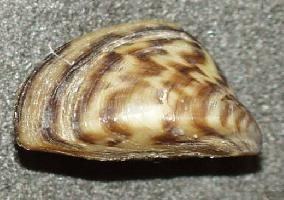
Popis zvířete
The Zebra mussel (Dreissena polymorpha) is a small, freshwater bivalve mollusk that has attracted significant attention due to its invasive nature and the ecological and economic impacts it has on invaded ecosystems. Native to the lakes of southern Russia and Ukraine, this species has spread to many other parts of the world, notably throughout Europe and North America, often through ballast water discharge from ships.Typically, Zebra mussels are small, with adults usually measuring between 2 to 5 centimeters in length, although some can grow slightly larger. They possess a distinctive D-shaped shell that is typically adorned with a pattern of dark and light stripes, reminiscent of a zebra's stripes, which is the origin of their common name. However, the pattern and coloration can vary considerably among individuals, ranging from almost entirely white to almost completely black, with many variations in between.
Zebra mussels attach to surfaces in the water using strong byssal threads, allowing them to form dense colonies that can cover virtually any hard surface, including rocks, submerged logs, water intake pipes, and even the shells of other mollusks. This ability to attach to surfaces and proliferate rapidly allows zebra mussels to dominate invaded habitats, outcompeting native species for food and space.
One of the most remarkable aspects of the Zebra mussel is its filtration capacity. An individual mussel can filter up to one liter of water per day, removing plankton, algae, and particulate matter. While this can initially lead to clearer water, the long-term effects can be detrimental. The reduction in plankton, which forms the base of the aquatic food web, can lead to decreased food resources for native fish and other aquatic organisms. Moreover, the accumulation of mussel waste on the bottom of water bodies can fuel the growth of harmful bottom-dwelling bacteria and increase the hypoxia (oxygen depletion) in the water, further stressing native aquatic life.
The reproductive strategy of Zebra mussels is another factor contributing to their invasive success. They are prolific breeders; a single female can produce over a million eggs per year. These eggs develop into microscopic, free-swimming larvae called veligers that drift with currents for several weeks before settling and beginning to form new colonies. This life stage allows them to spread over wide areas and invade new territories.
The economic impact of Zebra mussel invasions is profound, especially in areas where water intake pipes for power plants, municipal water supplies, and industrial facilities are present. The mussels can clog these structures, requiring costly maintenance and repairs. Additionally, their sharp shells can pose a hazard to swimmers and damage boats and other watercraft.
Management and control of Zebra mussel populations are challenging and often involve multiple strategies, including chemical treatments, physical removal, and the installation of protective screens over water intakes. Prevention of further spread is considered the most effective approach, emphasizing the importance of cleaning boats and equipment before transferring them between water bodies.
In conclusion, the Zebra mussel is a fascinating yet problematic species. Its distinctive appearance, remarkable filtration ability, and prolific breeding make it a unique organism, but its invasive nature and the negative impacts on ecosystems, economies, and human activities highlight the challenges of managing non-native species in a globalized world.
Nové fotografie zvířat
Top 10 zvířat
- Chinese water dragon (Physignathus cocincinus)
- Galápagos tortoise (Geochelone nigra complex)
- Dolphin gull (Leucophaeus scoresbii)
- Japanese macaque (Macaca fuscata)
- Colombian red howler (Alouatta seniculus)
- Sea urchins (Echinoidea)
- Moustached guenon (Cercopithecus cephus)
- Diana monkey (Cercopithecus diana)
- Colossal squid (Mesonychoteuthis hamiltoni)
- Common house mosquito (Culex pipiens)